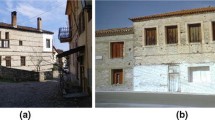Abstract
The efficiency of improving the seismic resistance of old masonry buildings by means of seismic isolation and confining the structure with CFRP laminate strips has been investigated. Five models of a simple two-story brick masonry building with wooden floors without wall ties have been tested on the shaking table. The control model has been built directly on the foundation slab. The second model has been separated from it by a damp-proof course in the form of a PVC sheet placed in the bed-joint between the second and the third course, whereas the third model has been isolated by rubber isolators placed between the foundation slab and structural walls. Models four and five have been confined with CFRP laminate strips, simulating the wall ties placed horizontally and vertically at floor levels and corners of the building, respectively. One of the CFRP strengthened models has been placed on seismic isolators. Tests have shown that a simple PVC sheet damp-proof course cannot be considered as seismic isolator unless adequately designed. Tests have also shown that the isolators alone did not prevent the separation of the walls. However, both models confined with CFRP strips exhibited significantly improved seismic behavior. The models did not collapse even when subjected to significantly stronger shaking table motion than that resisted by the control model without wall ties.
Similar content being viewed by others
References
Arias A (1970) A measure of earthquake intensity. In: Hanson R (eds) Seismic Design of Nuclear Power Plants. MIT Press, Cambridge
Bailey JS, Allen EW (1988) Seismic isolation retrofitting: Salt Lake City and County building. APT Bull 20(2): 33–34
Benedetti D (2004) Increasing available ductility in masonry buildings via energy absorbers. Shaking table tests. Eur Earthq Eng 18(3): 3–16
Bertero V, Uang CM (1992) Issues and future directions in the use of an energy approach for seismic resistant design of structures. In: Fajfar P, Krawinkler H (eds) Nonlinear seismic analysis and design of reinforced concrete buildings. Elsevier Applied Science, London, pp 3–22
Eurocode 8 (2004) Design of structures for earthquake resistance, Part 1: General rules, seismic actions and rules for buildings. EN 1998-1. CEN, Brussels
Fajfar P (1995) The sky-scaper of Ljubljana. Care for seismic safety in the 1930-ties. Report of FGG no. 38. In: Civil Engineer, Ljubljana, 34 (4-5-6) (in Slovene)
Gayevoy AV, Lissel SL (2004) Monitoring of CFRP prestressed masonry walls. In: Martens D, Vermeltfoort A (eds) Proceedings, 13th International Brick and Block Masonry Conference, Vol. 2, Amsterdam: 555–564
Hamilton HR, Dolan CW (1998) Strengthening unreinforced masonry with FRP. In: Srivastava NK (ed) Proceedings, Structural Engineering World Wide, Elsevier Science Ltd.: Paper No. T119–5 (CD-ROM)
Langhaar HL (1951) Dimensional analysis and theory of models. John Wiley & Sons, New York
Magenes G (1992) Seismic behavior of brick masonry: resistance and failure mechanisms of brick-masonry walls. Doctoral dissertation, University of Pavia. Pavia (in Italian)
Page AW (1995) The shear capacity of membrane type damp-proof courses in masonry. Aust Civil Eng Trans CE 37(1): 29–39
Sarrazin M, Moroni M, Boroschek R, Soto P (1996) Results from a base-isolated experimental building in Santiago-Chile. In: Sociedad Mexicana de Ingenieria Sismica, A.C. (ed) Proceedings, 11th World Conference on Earthquake Engineering, Acapulco, Pergamon, CD ROM
Schwegler G (1995) Masonry construction strengthened with fiber composites in seismically endangered zones. In: Duma G (ed) Proceedings, 10th European Conference on Earthquake Engineering, Vienna 1994, A.A. Balkema
Sheppard P (1989) Dynamic characteristics of tall, pre-1965 masonry buildings, as a basis for their seismic analysis and strengthening. In: Proceedings, Civil engineering dynamics, University of Bristol, Bristol: 25–42
Sheppard PF, Terčelj S (1985) Determination of the seismic resistance of an historical brick-masonry building by laboratory tests of cut-out wall elements. In: Proceedings, 7th International Brick-Masonry Conference, Vol.2, Melbourne: 1383–1394
Sheppard P, Tomaževič M (1986) In-situ tests of lateral load-bearing capacity of walls in old masonry buildings. In: Proceedings, 4th Congress of Yugoslav Association for Earthquake Engineering, Vol.2. Cavtat: 85–92 (in Serbo-Croat)
Skinner RI, Robinson WH, McVerry GH (1993) An introduction to seismic isolation. John Wiley & Sons
Soong TT, Dargush GF (1997) Passive energy dissipation systems in structural engineering, John Wiley & Sons
Taškov L, Bojadžiev M, Krstevska L (1984) Ambient vibration tests of old masonry buildings in Ljubljana. Reports No. 84–135 and 84–143. IZIIS, Skopje (in Serbo-Croat)
Tomaževič M, Lutman M, Weiss P (1996) Seismic upgrading of old brick-masonry urban houses: tying of walls with steel ties. Earthq Spectra 12(3): 599–622. doi:10.1193/1.1585898
Tomaževič M, Apih V, Lutman M (1994) Aseismic strengthening of historical stone-masonry buildings by building-friendly technologies. Mason Soc J 13(1): 41–55
Tomaževič M, Apih V (1993) The strengthening of stone-masonry walls by injecting the masonry-friendly grouts. Eur Earthq Eng 7(1): 10–20
Tomaževič M, Lutman M, Velechovsky T (1993) Aseismic strengthening of old stone-masonry buildings: is the replacement of wooden floors with r.c. slabs always necessary?. Eur Earthq Eng 7(2): 34–46
Tomaževič M (1987) Dynamic modelling of masonry buildings: storey mechanism model as a simple alternative. Earthquake Eng Struct Dynam 15(6): 731–749. doi:10.1002/eqe.4290150606
Tomaževič M (1989) Some aspects of structural strengthening of historic buildings in urban and rural nuclei against earthquakes. Eur Earthq Eng 3(1): 19–28
Triantafillou TC, Fardis MN (1997) Strengthening of historic masonry structures with composite materials. Mater Struct 30(10).
Triantafillou TC (2001) Seismic retrofitting of structures with fibre-reinforced polymers. Prog Struct Eng Mater 3(1). doi:10.1002/pse.61
Zhou X, Miao H (1996) Optimum design of resilience-friction-slide base isolation system for low cost buildings. In: Sociedad Mexicana de Ingenieria Sismica, A.C. (ed) Proceedings, 11th World Conference on Earthquake Engineering, Acapulco, Pergamon, CD ROM
Author information
Authors and Affiliations
Corresponding author
Rights and permissions
About this article
Cite this article
Tomaževič, M., Klemenc, I. & Weiss, P. Seismic upgrading of old masonry buildings by seismic isolation and CFRP laminates: a shaking-table study of reduced scale models. Bull Earthquake Eng 7, 293–321 (2009). https://doi.org/10.1007/s10518-008-9086-1
Received:
Accepted:
Published:
Issue Date:
DOI: https://doi.org/10.1007/s10518-008-9086-1




